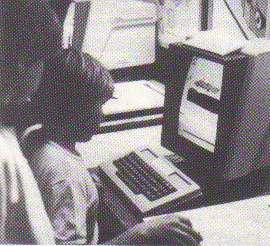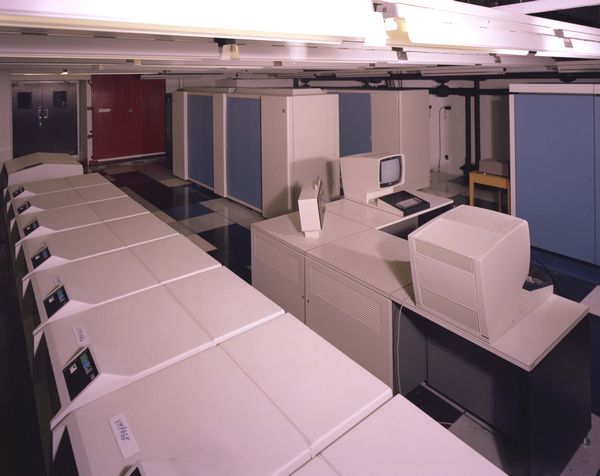

1982 was designated Information Technology Year. The Government mounted a national campaign to promote a wider appreciation in industry and among the general public of the opportunities and benefits offered by information technology; the Department of Industry's Alvey Committee presented its far-reaching report and the Department of Education and Science announced major additional funds to promote Information Technology research and training through SERC.
Universities and polytechnics have played a significant role in the development of information technology both through research and the training of skilled graduate manpower. In the last five years, the Council has launched several major initiatives to encourage support and to coordinate more academic activity in microelectronics, computing and communications. Special programmes have been mounted in microelectronic fabrication and distributed computing systems and, in 1979, the Engineering Board set up an Information Engineering Committee to direct and support further research. This article highlights some aspects of the Committee's programme which relate directly to the rapid growth of information technology.
At postgraduate level the Council has recognised the need for more integrated circuit designers and in 1980 set up three new MSc courses on 1C design (see page 13). Since 1980 some 40 graduates have been trained each year and most have taken posts directly in industry. In 1981, the Council established six digital systems laboratories at Brunei, Kent, Heriot-Watt, Bradford and Salford Universities and the Polytechnic of Central London to investigate various aspects of digital systems and to provide training for both postgraduate and industrial students to gain hands-on experience of modern microelectronic techniques. The Council is also collaborating with the Open University to produce a post-experience course on computer applications.
The growth in Information Technology has depended primarily on the revolution in microelectronics in the last 20 years. Council-supported device fabrication facilities are described in detail in pages 12 and 13. The facilities were established at a viable LSI level. The Council is now moving towards the VLSI capability and a recent grant of £1.78 million has been awarded to Edinburgh University which will allow much finer circuit geometries. University research is being supported not only into novel devices in such areas as integrated optics and optical signal processing but also into the exploitation of new ideas arising in semi-conductor physics including unidimensional conductors, modulation doping and metal insulator transistors. Most of this research is being carried out in direct collaboration with the leading microelectronics companies in the UK.
In 1977 the Council launched a coordinated programme in distributed computing systems. The objective of the programme was to establish the engineering principles necessary to implement such systems which offer a means of achieving very high speed and reliable processing more economically than increasing the speed of single processors. Research in the development of suitable programmable languages and the resource management of these systems was reported in Vol 2 No 5 of the Bulletin (Summer 1982). Significant developments have been made in the design and evaluation of new computer architectures. Cambridge University has developed a wide band digital communications ring intended to provide high speed local area networks. The Cambridge Ring is being used as the common hardware base for university researchers. An early commercial version is being exploited by Logica Ltd as a possible system for the 'office of the future'. A series of such ground-based local area networks linked by satellite forms the basis of the UNIVERSE project. This £3 million project is jointly funded by SERC, Department of Industry, GEC, British Telecom and Logica Ltd and involves the siting of seven earth stations in the industrial companies and at Cambridge and Loughborough Universities and University College London. The aim is to demonstrate and evaluate high bandwidth, high data rate transmission. UNIVERSE has great significance for UK information technology and should lead to a more widespread link between the rapidly growing number of computers in business, industry and the education system.
Under the distributed computing systems programme, Manchester University has been supported to design and construct a prototype Data Flow computer system. This system has many potential applications including weather forecasting, signal processing and intelligent systems.
In response to the Roberts Report (Proposed new initiatives in computing and computer applications) the Council has taken action to stimulate more industrially relevant academic research in software technology, database utilisation, systems reliability and man-machine interaction. Two consortia have been established, at East Anglia and Aberdeen Universities, in database utilisation, and a major grant has been awarded to Newcastle University to demonstrate to industry the effectiveness and practicability of reliability techniques in a command and control system.
In 1982, the Advisory Board for Research Councils (ABRC) endorsed the Council's proposals for a major growth in SERC support for Information Technology. The proposals were made in the context of the Committee, under Mr J Alvey of British Telecom, set up to develop a national programme in IT involving industry, government departments and academic research. The Council welcomes the Alvey Committee's report.
We now know that DBS has accepted the advice of the ABRC, who recommended a very significant increase in the funding of Information Technology research and training. This means that SERC can now increase research supported through grants in universities and polytechnics on a scale that will permit the support of much of the work proposed in the Alvey Committee report. In particular we expect to build up research in Software Engineering and Intelligent Knowledge Based Systems very significantly
The number of Fellows and Research Studentships in Information Technology-related subjects will also be very considerably increased. And there will be a large increase in the number of Advanced Course studentships we can support in IT-related subjects, including a number of new courses in universities and polytechnics designed to convert graduates from other disciplines. Altogether, by 1985-86, it is hoped to increase postgraduate numbers by over 1500 a year. Together with the new posts in IT departments that are to be provided with earmarked funds from UGC, the outlook for Information Technology research and training in universities and polytechnics looks excellent.

PERQ computers are being introduced by SERC into universities and polytechnics, where they are important aids in research projects. The PERQ shown here, however, was being used by one of 30,000 visitors to the Science Museum, Wroughton. This North Wiltshire outpost of the London Science Museum at present opens its doors to the public one day a year and on this occasion (12 September 1982) SERC provided one of the displays.
The design on the PERQ screen might have been inspired by two of the other SERC exhibits. A 1949 Morris Minor gave a reminder of one of the most successful British cars ever and an MG Metro indicated the way forward, highlighting some of the benefits that current SERCresearch is bringing to manufacturers such as BL.
Although the Central Computing Complex at RAL is in the middle of its most major upheaval for many years, the user population should see little other than an improvement in the service.
The report of the Computing Review Working Party, in December 1980, recommended an outline plan to replace the existing IBM 360/195s - then almost ten years old. Council, acting on the working party's advice, allocated capital to carry the replacement programme through.
In May 1982, Council approved two major computer purchases for RAL: the IBM 308ID, and the ICL Atlas 10 (see Bulletin Vol 2 No 6, Autumn 1982). The 308ID, one of IBM's new series of machines, has almost as much power as both the 360/195s together. The system was delivered on 7 July 1982 and installed within a day. After checkouts, operator training etc it entered service on the 19 July 1982, replacing one of the 360/195s. It was configured to take on the 'front-end' role (supporting the interactive and communications work as well as batch) on 12 August 1982, two weeks ahead of the initial schedule. There have been no problems apart from one early fault involving the replacement of a processor component.
The second 360/195 was removed from service in October, and then both the 360s were physically removed from the building - a major exercise in itself. Fortunately the cost of this was amply compensated for by the scrap value which, since there is gold in many of the circuits of these old computers, was considerable.
The ICL Atlas 10, manufactured in Japan by Fujitsu, is one of the most powerful IBM compatible computers in the world: its single processor has about the power of three 360/195s. The Atlas is expected in mid 1983 but since it will be the first of its kind in the UK, RAL and ICL will take a few months subjecting it to various tests before it enters full service in October.
This will complete the major processor replacements and enable RAL to concentrate on plans for other hardware and on a software programme which will bring the facilities once more up to the standard demanded by our scientific users in universities and polytechnics and at RAL.
